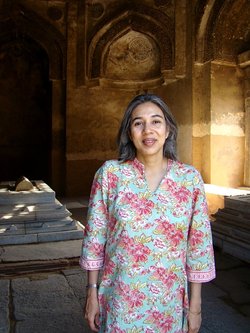Well-known historian and author Swapna Liddle picks some heritage gems of Mehrauli, Delhi:

Thousands visit the world heritage site of Qutub Minar in Delhi, but not many know of the historically rich area of the Mehrauli Archaeological Park in its immediate neighbourhood. The Mehrauli area (where Qutub Minar is located) has been continuously inhabited for probably more than a millennium. The park is situated mostly to the south of the mid-eleventh century fortified city of Lal Kot, often called the ‘first city of Delhi’. Portions of the ruined city wall can be seen here, but what is special about the archaeological park is the fact that it has seen construction down the centuries. One sees buildings from different eras, representing a wide range of styles and functions at Mehrauli, Delhi. Moreover, all this is set in a green area that is an oasis in the metropolis.
The tomb of Emperor Balban, who reigned between 1265-87, is one of the oldest structures located in the park and represents probably the first use of the true arch on Indian soil.

Architectural Story of Mehrauli
Before the advent of the Turks in the late twelfth century, Indian builders were not familiar with the arch in construction. The earliest buildings, commissioned by the early Sultanate rulers Qutubuddin Aibak and Iltutmish, saw the first unsuccessful experimentations with arcuate forms (seen in the buildings of the Qutub complex). The ruined tomb of Balban however exhibits a true arch for the first time.
The area is dotted with a number of tombs and graves, as people considered it particularly suitable for burial. The reason for this is that the dargah (shrine) of the thirteenth-century Sufi saint Qutubuddin Bakhtiyar Kaki lies just outside the precincts of the park, in the historic village of Mehrauli, Delhi.During the early sixteenth century, they constructed a pavilion tomb with a small but beautiful mosque not far from the shrine.They built next to it what is probably the most beautiful step-well (or baoli) in Delhi – the Rajon ki baoli. It stands on four levels, with arcaded rooms surrounding the pool. This would have provided water to the local community, as well as travellers who could have found shelter here.

Sufi Stories
In the sixteenth century, a thriving population settled in the valley of a stream that drained this area. Maulana Jamali, an important Sufi, also made this place his seat. He built a beautiful mosque in this area. After his death in 1535, they buried Maulana Jamali in a small tomb next to the mosque. This tomb is a small gem of a building.

The interior walls and ceiling of the building have intricate decorations. The decorations include finely carved and coloured limestone plaster, tile, and marble. Verses of Maulana Jamali’s poetry adorn the walls. In the centre of the mihrab or prayer wall, there is a carved purnakalash. The purnakalash is an auspicious Hindu ritual vessel. Made of marble, the purnakalash holds significant cultural and religious symbolism.
This truly represents the syncretic beliefs of the Sufis, who incorporated Hindu symbols and thoughts into Islamic beliefs and practices. The Sufi legacy reaches out to people of all faiths, making it an enduring part of the subcontinent’s culture. Shrines like Nizamuddin Auliya and Muinuddin Chishti attract devotees of all faiths even today.
Excerpted from an article published in Travel Secrets magazine (March-April 2012). Text & pics by Swapna Liddle, author of Delhi: 14 Historic Walks
Check out our latest posts here:










